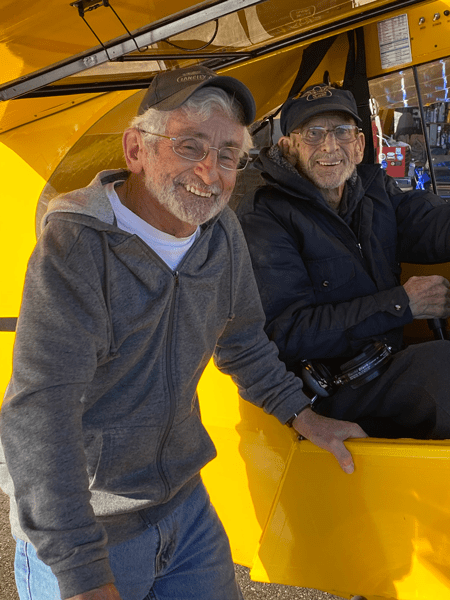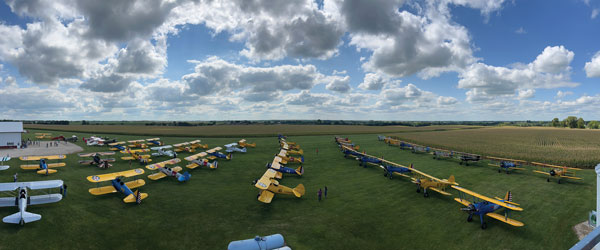
By Mike Davenport, EAA 89102, Langley, British Columbia
Most Canadians work quietly at their jobs, not requesting or expecting acknowledgement of any kind. However, there are those who must be recognised as their efforts far exceed the norm, and Werner Griesbeck was one of those individuals. This past December, Werner “flew west” after a long fight against several cancers. A man whose skills were legendary as a pilot (having logged more than 5,500 hours), aircraft restorer, and as a person who shared that love of aviation until the day he died.

Born in Bavaria in southern Germany in June 1943, Werner moved to Canada with his parents in the early 1950s, eventually arriving in Mission, British Columbia, where his father started a bakery.
In the early days, he worked for his father in the family bakery, pulling the early shift, 3 a.m. until whenever, earning the money that went to flying lessons in 1964 at the Abbotsford airport. He became a flight instructor, an air traffic controller, an antique aircraft restorer, and a model airplane builder. He was a man of many talents and one who was willing to share his knowledge, talent, and time for anyone who would show an interest.
He worked as a flying instructor from 1966 to 1970 that included a stint running a remote school in Powell River, British Columbia. Later in 1970, he joined Transport Canada and worked as an air traffic controller initially in Abbotsford, then in Langley, and then back to Abbotsford until he retired in 2000.

He and his wife, Wendy, built a log home in Aldergrove and later added a small shop. When his neighbour needed a bigger shop for his trucks, Werner negotiated a deal to get the original smaller one. This he added on the back of the original, lifting it over the fence with a crane, thus increasing his shop space by more than 125 percent. Now he had the front for a paint shop and the back for fabric work, and each could stay clean.

His passion for flying included the mechanical side, completing award-winning restorations of more than 20 classic and antique aircraft including at least five J-3 Piper Cubs, a Piper L-4, a 1931 Waco RNF biplane, as well as his 1941 Porterfield CP65 Collegiate in 1981 and the 1938 Fairchild 24K in 1991. Both he flew cross country to display them at the EAA fly-in convention. His craftsmanship was acknowledged with a variety of awards (14-plus) from his peers at Delta Air Park, Arlington; Evergreen, Washington; Hood River, Oregon; and as far away as Merced, California, and Oshkosh, Wisconsin, in 1995 where he received the plaque for “Outstanding Closed Cockpit Monoplane” for his work on the Fairchild.

He had obtained his airframe license in the 1980s, allowing him then to do annuals and sign out his own work. He and Dan Holliday together built a Marquart Charger, and he assisted on the construction on Dan’s Piper. He played a major role in the completion of Jim Briton’s Staggerwing. He even somehow found time to help me with my Stinson, both in painting and in an engine change, as well as many annuals. His most recent was Cam Leslie’s J-3 Cub, which has the distinction of being the oldest Canadian-built Cub still in existence.
He gave many area pilots their tailwheel checkouts, and they include the whole gamut of aviation from private pilots to many who went on to become commercial pilots with careers in both corporate aviation and with the airlines. These checks included the writer, insisting on only three-point landings and laughing madly when things went a bit sideways. In my case, these checkrides included his Porterfield and the museum’s Fleet Finch 16B. He also checked me out on the Mooney Mite, a single-seat retractable aircraft. This was memorable in the method he used. Together we picked up this little airplane and set it on sawhorses so that I could figure out where the important stuff was and how to retract and lower the gear, all under his supervision.
Werner’s commitment to general aviation was absolute. He was interested in almost every organization and maintained memberships in most.
His membership in COPA was important to him, keeping him up to date on aviation in Canada.
He was a longtime EAA member and a member of EAA’s Vintage Aircraft Association. He was an early supporter of EAA’s Young Eagles program and helped organize first flights for some 700-plus kids here at Langley. He personally flew more than 100 kids.
He was a director of the Canadian Museum of Flight here in Langley, British Columbia, and for a period applied his expertise in both maintenance and flying to the Waco Cabin, the Fleet Finch, and the Tiger Moth. When the Mooney Mite was sold, he delivered that to the new owner in Washington state.
The Arlington air show in Washington state benefited from his expertise as a judge in the antique and classic classes.
The Abbotsford International Airshow also saw him participate in many fly-pasts, either in one of his own classics or the museum’s biplanes.
His skills were acknowledged by many all over the Pacific Northwest. It was impossible to go anywhere with him and not meet some of his many friends and associates.
His work has been acknowledged in articles in EAA’s Vintage Airplane, Flight Journal, COPA, Recreational Flyer and in my book, People Places and Planes.
He is being missed.
Post Comments



